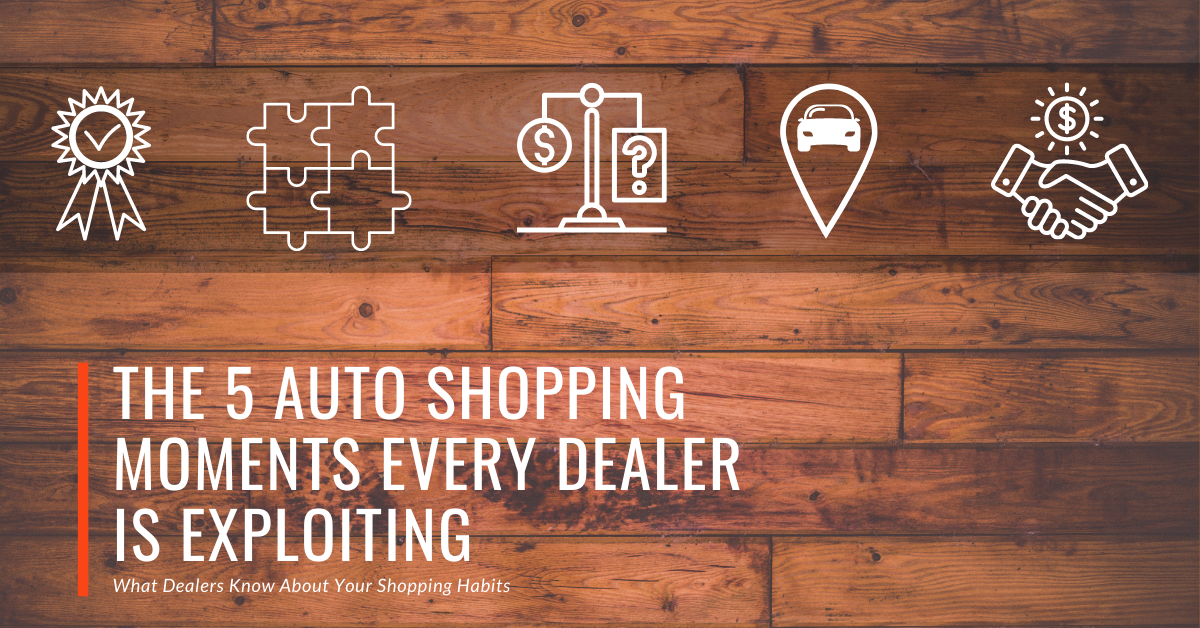The first thing you need to navigate the world of used auto sales is a map. Luckily, marketers and dealerships themselves have given us theirs—a glimpse at the way they approach the car selling process.
Once you have a sense of how they predict your behavior, you’ll be better positioned to take control of your own choices.
The map we’re going to use was published by Think With Google almost five years ago, but it’s still the best breakdown out there. It identifies five key moments within the messy process of hunting for and purchasing a car.
Each “moment” is defined by a question you’re trying to answer but from the dealers perspective is insight into your predictable behavior. Armed with the knowledge that you are likely to consume certain content and use certain tools, the dealers are at an information advantage.
Here they are.
1. Moments where you’re asking, “which car is best?”
These are moments where you’re not sure what you’re looking for, so you turn to some handy source of expertise. That might mean asking a car- savvy friend, watching YouTube videos, browsing reviews sites like Edmunds or Car and Driver, or reading forum posts.
For a dealership, these moments are opportunities to get you fixated on details like make or model, so that they can lean on those preferences to over-charge you later on.
The way to escape is to ignore the marketing and focus on your most important needs: size, shape, and capability. Don’t get too attached to any one option.
2. Moments where you’re asking, “is it right for me?”
These moments are all about features: gas mileage, towing capacity, sun roofs, speaker quality, number of airbags, bluetooth, lane assist. Dealerships know you’re going to be watching test drives, reading first- hand accounts of cars with the latest tech, and making a list of what you’re
looking for, and they capitalize on that by selectively listing attractive features online.
Your big goal here is to make sure that these relatively minor details don’t drive your decision-making process. Keep your focus on condition and availability, and only then ask which option is best for you.
3. Moments where you’re asking, “can I afford it?”
A major part of every car-buying process is budgeting. Dealerships and marketers are counting on you to jump online and check list prices and MSRP values using a service like Kelly’s Blue Book. That lets them manipulate you by posting cars under misleading prices.
The way to approach these moments is to work out your budget before you start looking at cars. Compare estimates of your current car’s trade-in value at multiple dealerships, and use that to help you define an acceptable price range…and then stick to it.
4. Moments where you’re asking, “where should I buy it?”
The choice of dealership is tricky. Dealerships themselves count on you reading their reviews (which is a good idea), going to wherever is closest, and—most important of all—trusting their online inventory listings.
Don’t. Instead, start with the reviews, and then look for dealerships that might be genuinely trustworthy. They’re few and far between, but check our guide on how to find them here. Once you’ve identified a dealership, have them help you identify a list of cars in your area. If the dealership is worth your time, they’ll look outside their own stock, so you won’t be limiting your options.
5. Moments where you’re asking, “am I getting a deal?”
Here, again, dealerships plan to manipulate you using online tools. They’ll offer what looks like a good deal while hiding key information about condition, location, extra fees, or other problems.
The simple fact is that you’ll never find a car that’s above average market quality for below average prices. Looking for a steal is a guaranteed way to end up with a clunker.
Instead, look for a fair deal—something an honest dealer might realistically offer.
And that’s it!
Those are the five big moments that most shoppers experience.
Ultimately, we’re going to recommend a very different approach to car-buying: one that starts by looking at actual, physical vehicles instead of just makes, models, and features, and that focuses on condition instead of price.
For now, you’re better-prepared to make your own choices and avoid dealership tricks.

